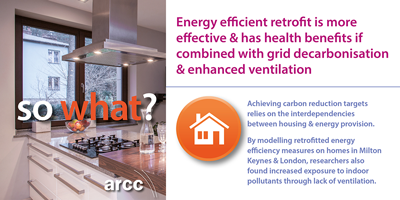Investigating the comparative impacts of dwelling-related CO2 reduction strategies in London and Milton Keynes, researchers devised a number of future scenarios with varying combinations of housing retrofit measures and degrees of energy supply decarbonisation. These were used to calculate possible end-user energy demand, indoor pollutant exposures and health impacts at each location.
Scenarios
Researchers modelled the current (2010) and possible future (2050) housing stock of a town (Milton Keynes) and a city (London).
Three potential levels of energy efficiency interventions were considered against two future approaches for UK electricity provision:
Business as usual (no decarbonisation of the electricity grid)
Scenario 1: Energy efficiency (double glazing with trickle vents, extract fans, cavity wall filling, solid wall insulation & loft insulation).
Scenario 2: Energy efficiency plus (above measures + heating focused interventions e.g. condensing boilers and central heating).
Accelerated decarbonisation of the electricity grid
Scenario 3: Low carbon supply as scenario 1 measures + major decarbonisation of the electricity grid).
Health impacts
- For London: where CO2 reduction targets are the main policy driver, substantial reductions can be made with housing energy intervention, mainly due to the age of the existing stock, its construction and lower overall energy efficiency. Potential net benefits or harms to health are greater in London, measured in terms of gains in life expectancy.
- For Milton Keynes: the potential percentage emission reduction gains from energy interventions on housing are much smaller due to the already energy efficient housing stock. Decarbonisation of the grid is essential in achieving CO2 emissions reduction targets, especially in Milton Keynes.
Findings
- Possible energy efficiency gains in housing vary substantially between different locations.
- Aggressive decarbonisation of the electric grid is essential in achieving CO2 emissions reduction targets.
| Scenario | % reduction in CO2 emissions from housing stock 2010–2050 | |
|---|---|---|
| London | Milton Keynes | |
| BAU: No electric grid decarbonisation | ||
| Scenario 1: Energy efficiency | –50% | –34% |
| Scenario 2: Energy efficiency plus | –56% | –42% |
| Aggressive electric grid decarbonisation | ||
| Scenario 3*: Energy efficiency | –97% | –96% |
Ventilation strategies
The results also reveal that including enhanced ventilation* has a substantial health impact – without it, there are large increases in exposure to pollutants derived from indoor sources. This increase more than offsets the benefits of improved indoor heating season temperatures and protection against outdoor air pollution, resulting in substantial negative impacts on health overall in both settings.
* Enhanced ventilation involves the addition of extraction fans in all wet rooms (kitchen, bathroom and toilets) and the application of trickle vents to all new double glazing.
Findings
- In both locations, the direction of health impacts, whether negative or positive overall, are dependant on the use of enhanced ventilation strategies in conjunction with energy efficiency measures.
- Without this CO2 reductions are made at the expense of human health.
| Scenario | Modelled change in life years over 40 years from 2010-2050 | |
|---|---|---|
| London | Milton Keynes | |
| With enhanced ventilation | ||
| Scenarios 1 and 3 | 849,800 | 21,200 |
| Scenario 2 | 856,500 | 21,400 |
| Without enhanced ventilation | ||
| Scenarios 1 and 3 | –1,043,900 | –13,800 |
| Scenario 2 | –1,041,000 | –13,700 |
| Health impacts changes in life years are shown over 40 years for each city population for each scenario (– indicates life years lost) | ||
Now what?
We demonstrated that combining simple home refurbishments with electric grid decarbonisation can achieve carbon reduction targets in locations with very different stock profiles, whilst minimising future health risks.
To minimise future health risks, careful consideration of options for individual building components need to be made when designing energy efficiency retrofit strategies.
Greater emphasis on electric grid decarbonisation would simplify energy efficient refurbishment strategies, whilst minimising the risk of indoor overheating and poor indoor air quality. Financially effective ‘win-win’ retrofit options that are not detrimental to human health and combine climate change mitigation and adaptation measures can be more easily identified.
Local & national policymakers
- Consider a greater emphasis on electric grid decarbonisation policies and reduction of gas use in the domestic sector when planning CO2 reduction budgets.
- Ensure ventilation is a clear element in refurbishment legislation.
- Collate and provide access to sources of data on good practice in energy refurbishment.
Researchers
- Investigate pre- and post- retrofit homes to provide empirical data sets on practices and examples of both positive changes in indoor air quality and negative practice to feed back into policy.
Architects / retrofit providers
- When designing new homes, incorporate adequate ventilation and cooling strategies to ensure indoor air quality early in the design process and not as an afterthought.
- When retrofitting existing homes, take account of the changes in ventilation that are likely to occur when energy efficiency measures are applied.
- Take account of the particular dwelling and the occupancy patterns to avoid ‘one-size-fits-all’ solutions.
- Investigate and specify / offer components using renewable sources of energy.


